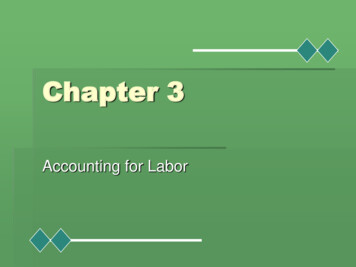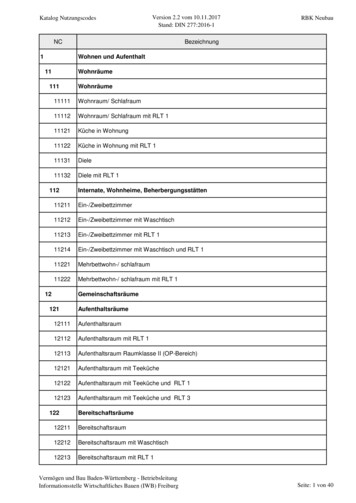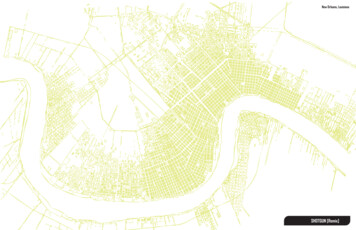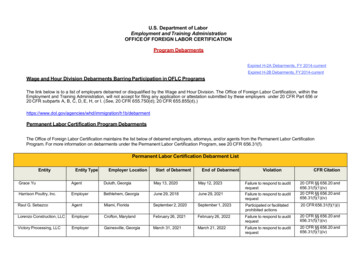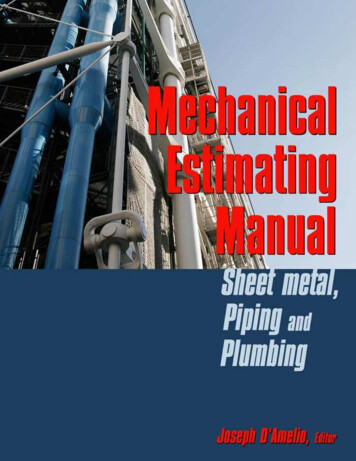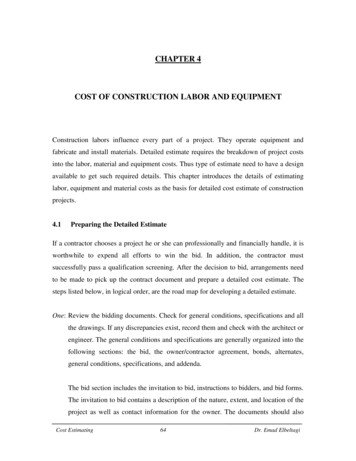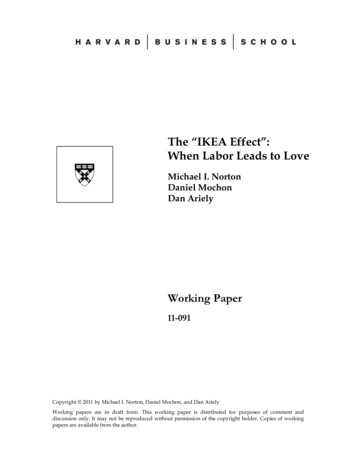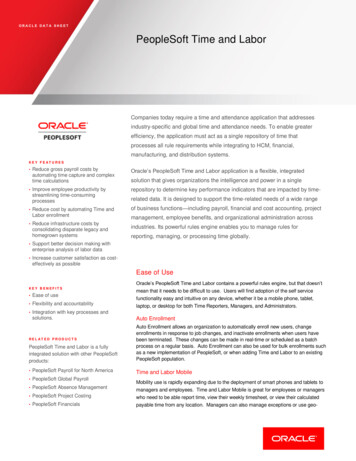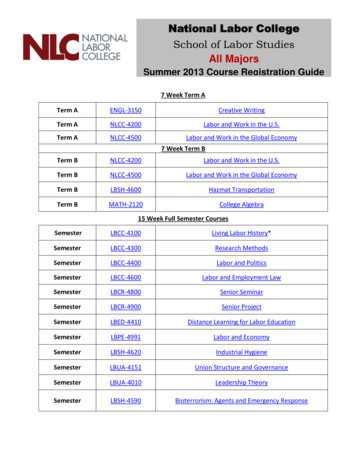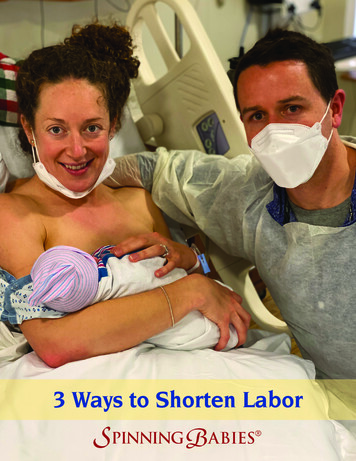
Transcription
3 Ways to Shorten Labor
3 Ways to Shorten LaborWritten by Gail Tully Creator of Spinning Babies with the aid of Christina McBride, doula; Corie McPursifull, teacher of Health;and Jennifer Walker, Spinning Babies Approved Trainer.2020 Maternity House Publishing, Inc. ISBN- 978-0-9908307-7-13 Ways of Shortening LaborGail Tully, CPM10545 Humboldt Avenue SouthBloomington, MN 55431Gail@SpinningBabies.comImages: Cover photo with permission of parents. “Chanté” taken by Chris McBride. Bellypainting by Trish Gardiner. Couple in Abdominal Lift and Tuck taken by Megan Crown. Foot onrolls of toilet paper taken by Alli Parfenov (Indigo Birth Photography). New mother with herdoula (Bee Johnson) on smart phone is taken by the new father and is used anonymously bypermission. Placenta in bowl while baby is skin-to-skin by Gail Tully. Gail Tully on final page byKristin Tangen.Special thanks to Ruthie Nelson for editing and Kate Doll for designing the book layout.Visit SpinningBabies.com for more on pregnancy, techniques, and the reason why.Find products, events, and online classes at http://spinningbabies.com/shop/Subscribe to our free Pregnancy Week-by-week or monthly emails.3 Ways of Shortening Labor is copyrighted. That means you do not have permission to copy,print, or post or in any way publish excerpts in your website, social media or printed materials,except to use two or three sentences to review or as a reference back to SpinningBabies.com ina social media post.We do give permission to share the pdf in whole for free. You can share the complete pdf. Wehope you do widely share news of this free gift to parents giving birth in trying times.The link to share isHyperlinks are included in this pdf for your convenience
Table of ContentsA Natural Balance. 5In Pregnancy . 9Contraindications! . 11The First Way to Shortena Labor Is Before Labor. 12Belly Mapping . 16Birth Plan. 16Labor. 20The Second Way to Shorten Labor; Helpbaby into the entrance of the pelvis . 22Active Labor. 26The Third Way to Shorten Your Labor:Help baby emerge more easily. 29Home or Birth Center Birthing. 34After the Birth. 36Spinning Babies VirtualSupport for Parents. 41Public Statement . 43Resources. 43
Our book opens with Richard’s email toSpinning Babies about the birth experience ofhis wife, Caroline—which is his experience, too.I just wanted to drop you all a note to say thank you for all the terrificinformation you make available on your site. My wife just deliveredour first son yesterday.She was in labor for 63 hours, we were doing an all natural birth at ahospital and spent most of the labor at home on our own (no doulaor midwife). While we had read many books on natural childbirth(Bradley Method and the like) we were feeling stuck and frustratedafter 2 days of strong, persistent contractions that labor was notprogressing like the textbooks said it would.In scouring the internet for answers, I stumbled [upon] your site andread all about baby positioning, and became convinced that althoughwe knew he was in a good position head down (what I now know asLOT) he seemed to be stuck and not engaged (although we have noway to know for sure as [we] were not checked).So on day 3, we set out to follow your prescribed exercises, a fewrounds of Rebozo sifting, 3 rounds of Side-lying Release each side,lots of hip dipping and then 10 rounds of Abdominal Lift and Tuck, andwham, within 2 hours she had lost her mucus plug and we were inbusiness. We arrived at the hospital 6 cm dilated and he was born justover 3 hours later.It was so helpful to be able to refer to your site and to have someexercises to try, I am convinced they made the difference anddefinitely helped us avoid going to the hospital way too early andending up with a medicated or cesarean birth.Thank you! I am going to be referring all our future parent friends toyour site so they have all this great information much earlier than wehad found it.Cheers,Richard
A Natural BalanceSpinning Babies offers parents, like Richard and Caroline, information about“what to do” when they don’t know what to do. Parents can sometimes findthemselves in an unexpected and, sometimes, seemingly endless long labor.Having a cesarean is a big decision, and it isn’t a simple choice. Surgery hasrisks like postpartum pain, blood loss, and higher risk of infection. Time andtypical birth positions don’t always give the answer.Spinning Babies comes in with solutions for many situations, including longlabors, back pain, labor pain, and babies not being in a good position to fit thepelvis, and simply offers calm and more ease.But wait: I hear someone somewhere asking, “Doesn’t the body know what todo? Birth is something the body just does, right?”True, the body is designed for birth: the uterus leads to the vagina; the vaginaleads through the pelvis to the outside world. Baby turns through the pelvis andslips past the cervix and over the perineum.But then there’s the modern world. Sitting for hours, driving in cars, a lack ofexercise, or too much exercise can affect the muscles, causing them to be tootight or too loose or to actually twist away from the curving path that is just theright angle for the baby to descend through the body.There is a natural balance the body needs to direct the baby into the pelviswhen the uterus is contracting to push the baby through the pelvis. The normalprocess of birth can be nurtured and protected to reduce the need for heroichelp. And though birth doesn’t always wait for a secure location or time, youcan find security in knowing you can do things to ease birth for your baby andyour birthing body.3 Ways to Shorten Labor5
3 Ways to Shorten Labor6
Our Three Ways to Shorten Labor e-book is a gift of support to pregnant peopleneeding to be self-sufficient in labor. Whether you’re giving birth under normalcircumstances or giving birth during a health pandemic, weather emergency, orother national or global event, the guidance here will help. When providers arebusy with emergency response measures, parents may need to be quite selfreliant.At the same time, this isn’t a how-to-give-birth-on-your-own book. This e-bookis a public service from SpinningBabies.com and is not a replacement formedical or midwifery advice. Seek a medical professional for pregnancy andthe doula and childbirth education communities for birth support.In extreme times, parents may be looking for a personal guide to help themnow! We also have a growing community of Spinning Babies Certified ParentEducators offering Online Guided Spinning Babies Parent Classes. Find ourParent Educators at edparent-educator-directory/.We are pleased to give birthing parents of the world this simple e-book to helpease labor. Our immediate desire is to reduce labor time. A shorter labor ishelpful because it typically means: Less overall time in the hospital Fewer interventions that might lengthen time in the hospital Shorter time exposed to contagions and pathogens fromother people in the hospital Less physical exhaustion and more energy for welcoming babyEasing labor with our physical preparation programalso helps to increase: Parent confidence Ability to cope with contractions Knowledge for self-help during childbirth Body balance to let baby turn and slip down the pelvis3 Ways to Shorten Labor7
We’re sharing this e-book and expanding our services online to help parents beproactive when midwives and medical providers may be focused on handlingemergency measures while also caring for birthing families.Generations of your direct ancestors have successfully given birth. And evenif you, your mother, and/or your grandmother were born by cesarean, you canprobably trust your pelvis, knowing a few generations is absolutely too short atime for evolutionary change in the human pelvis to reduce your body’s abilityto give birth.A pregnant person without significant skeletal or unmanaged metabolicdifferences can complete labor with a vaginal birth and benefit from thehormones released throughout the entire labor process. Labor enhances bothyou and your baby.The oxytocin hormone surging in a birthing body prepare a new parent towant to gaze into baby’s eyes, feed, and perceive the needs of the baby, and betransformed by this process—literally, chemically, and therefore emotionallyand psychologically.The hormones of labor allow the uterus to massage a baby down through thepelvis and also to stretch the vagina over baby’s head. The joints of the bonypelvis become even more flexible than in pregnancy. The great thing about birthis that it happens whether we know “how to do it” or not. The body is busy withinternal preparations regardless of our will or knowledge.Birth is neither a crisis nor an excuse to be passive. Your body may need thesupport of your exercises or the stretch-and-jiggle techniques promoted bySpinning Babies to loosen a body stiffened by years of sitting or standing inplace sports or accidents.Modern life doesn’t offer many opportunities to move our bodies with the fullrange that benefits our pelvis and back. Lacking a balance between flexibilityand stability, our pelvis can be less responsive to our own ability to give birth.We can restore that ability. We’ve developed proactive activities—which myfriend Chris McBride calls proactivities—to enliven your ability to give birthanywhere and any time.3 Ways to Shorten Labor8
In PregnancySupport your body. You’re doing amazing work. Take action for an easierbirthing experience: Sleep 7–8 hours over 24 hours, with a nap each day and by going to bedearly. Drink 12 glasses of non-carbonated water a day, and eat nourishing food. Breathe in deeply and exhale slowly—many times in a row, several timeseach day. Begin to stretch your joints and muscles in every direction, slowly andrepeatedly each day.And finally, if you have time, try the birth positions and special stretches andjiggles we offer here so you have practiced them and gotten the feeling of themin your body before labor begins.Prepare Yourself for a New Kind of BirthThe birth you may have envisioned will change to fit the current situation onthe day you are in labor. Before you can feel fully confident, you may haveto say goodbye to current hopes and expectations that may be less likely inwidespread emergency situations.Allow yourself to feel grief for the loss of the birth you initially expected. Thisis a time to activate your creativity in facing challenges. Parenting requiresconstant flexibility to foster growth. Perspective and humor help you moveforward. The old script doesn’t fit the new world stage.You are about to rewrite your new script to include changes and adaptationslike: Birthing with fewer support people Finding your body’s own resources—with breath and movement Appreciating yourself in the unique, historic moment this is Welcoming your baby as a member of a new and vital generationfor Earth’s futureWhen life as we know it changes, we can open ourselves to new skills for anew world or try to keep the world as it used to be. These opposite urges of3 Ways to Shorten Labor9
adaptation and stability are both speaking to important needs: to be safe andsecure but also to navigate the unknown by taking risks to change. Both areways to cope. A little of each is necessary and both have value. But it is curiositythat keeps the mind open so you can learn from people already adapted tohelping birthing and parenting families in the current time.Prenatal Connection“Don’t forget the baby inside,” says Your Amazing Newborn author PhyllisKlaus. Your baby has a very active womb life. Your movements gently rock yourbaby, which helps their physical and neurological development. Your speakingand singing voices become familiar and comfort baby when they hear you afterbirth. By seventeen weeks, your baby can easily hear you and the sounds ofyour daily life.Dedicate a special time each day to sing a specific song. The baby will begin toanticipate your voice and the emotions singing can release in your body. Wantto see an example? Witness a baby’s heartbeat during a familiar song in theshort video “Singing to the Baby” by Penny Simkin.Lullabies enhance social development and encourage a deeper connection.Include the whole family. After birth, your baby will be soothed by the familiarsongs learned in gestation. The result is delightful. You have proof your babyknows and remembers.3 Ways to Shorten Labor10
Contraindications!When Not to Use Our RecommendedSpinning Babies TechniquesBefore we get into our “proactivities,” we want you to knowthat not everyone can or should do everything we recommendin general.Know the medical contraindications; don’t do anything thatworsens a medical condition like high blood pressure orbleeding in pregnancy. Read contraindications for yourself.Take a moment to consider whether this technique is right foryou. Check in with your body, sensing comfort or resistance,and honor that as inner guidance. Stop and do something elseor rest if what you are doing doesn’t feel right.Talk with your midwife or doctor about concerns.Don’t do these techniques when there’s a medicalreason not to: Constant pain and hardness of the abdomen betweencontractions High blood pressure or other risks of stroke, like severeheadache or seeing flashes of light Or if you simply don’t want toSee explanations at When Not to Use Spinning Babies .I hope that by knowing the contraindications, you will feelconfident with the techniques recommended at SpinningBabies and that those of you who can use the techniqueswill experience the benefits of physiological birthing in moregentle experiences of spontaneous birth.3 Ways to Shorten Labor11
The First Way to Shortena Labor Is Before LaborProtect the Balance Already in Your BodyBalance in the body means muscles and ligaments are not too tight, not tooloose, and not twisted and pulling the uterus off direction. A body in balancewill function better. Birth may then be easier than when we don’t nurture thebalance in our body.Supple MusclesDaily stretching brings comfort to pregnancy andprepares for an easier childbirth. Aligning your bodyand doing a gentle but lasting stretch can lengthenthe muscles. Long muscles are supple muscles. Theyfunction well.Legs and joints and vertebrae that move freely havemore options in labor than those that are stiff or onlyflexible in a few directions. Bikers and walkers, forinstance, may need to increase their range of motionby including side lunges. At Spinning Babies , specificstretches were chosen to address a variety of musclesand ligaments so space expands for a baby to getthemselves into an ideal position for birth.We’ve created a Daily Activities section onSpinningBabies.com where you can follow a list withpictures and instructions. Select several activities fora daily 30-minute stretching session. Mix the different techniques throughoutthe week to include most, if not all, of the activities.3 Ways to Shorten Labor12
Rest Smart Rest Smart suggestions maintain your balance during pregnancy. Thesepostures and positions can also be used in labor. Think of your belly as ahammock, and let the baby lie with his or her back settling into the hammock.Don’t “tuck your tail” while standing, except for specific techniques.You’re sitting up on your sitz bones, lying on your side with knees and anklessupported, and finding symmetrical, or twist-less, positions. Visit the RestSmart page on SpinningBabies.com to learn more.3 Ways to Shorten Labor13
Restore BalanceTo increase your likelihood of a physiological birth that is manageable withbreathing and moving, natural comfort measures, and support, add bodybalance. Balance in the body simply means “not too tight,” “not too loose,” and“not too twisty.”A uterus can get a bit of a twist in the lower portion from a sudden stop or fallwhile the body or car is turning. Get your birth design back in action: Releasewhat’s tight, support what’s loose, and untwist the ligaments!We have collected an assortment of techniques to bring the body back intobalance that we call the Three Sisters of BalanceSM. While popular for theirsuccess, these techniques also have warnings so you can use them safely. Donot use any of these techniques if there is bleeding in pregnancy that is not dueto normal cervical dilation.The Three Sisters of BalanceSM have a cousin too, another technique. We aren’tincluding instructions and photos in this ebook on purpose. We want to keepyou up-to-date when there are updates, and also provide a fuller context forbetter use of techniques by directing you to our website. Begin balancing nowby following this link: he-fantastic-four/.Experience Calm with the Rebozo Manteada“Manteada” is a gentle sifting, like a rhythmic jiggle. “Manteada” is the Spanishname for the gentle sifting action with the Rebozo, a special woven scarf.Manteada is done by Mexican midwives for comfort during pregnancy, birth,and postpartum. This description was shared with Spinning Babies by midwifeXimena Rojas García. Manteada with the Rebozo aims to: relax tight uterine ligaments and abdominal muscles, help the baby rotate in pregnancy or labor more easily, and help the birthing person relax into labor.The Rebozo is a very long woven scarf created by women for women. Thebeautiful traditions of using the Rebozo are handed down from mother todaughter and midwife to midwife in Mexico and Central America. The manyuses of the Rebozo include carrying a baby, relaxing and repositioning mothers3 Ways to Shorten Labor14
in childbirth, carrying groceries, and most especially, ceremonies for importantpassages of women’s lives.Visit the Rebozo Manteada section on SpinningBabies.com to learn more.Untwist Any Pulled Ligaments with Forward-leaning InversionThe Forward-leaning Inversion (FLI) restores optimal room in the lower uterus.Baby will use that space, with the pull of gravity, to snuggle their head into amore ideal position for birth.Staying in this upside-down position for 30 seconds—three breaths only—helps the head-down baby tuck their chin when done one time a day. TheForward-leaning Inversion technique was developed by Carol Phillips, DC, ofDynamic Body Balancing.Read the Forward-leaning Inversion section on SpinningBabies.com to learn theright way to do it, how to avoid a fall, and when it’s not safe to go upside down.Observing the safety measures you read on the website and going slowly willreduce accidental falling.Of course, we encourage you to listen to your body. If you have a gut feeling notto go upside down, don’t do it! Trust yourself.Untighten and Untwist with the Side-lying ReleaseThe Side-lying Release (SLR) uses a “static stretch” to temporarily, slightlyenlarge and soften the pelvis. Stretching the muscle spindles lengthens thepelvic muscles for approximately one to four hours. The SLR can then berepeated if needed.Visit the Side-lying Release (SLR) section on SpinningBabies.com or visit thewebsite of Carol Phillips, DC, the developer of SLR, to learn more.Support What’s Loose with a Pregnancy BeltWrap a long, thin linen cloth under the belly, and tuck the ends into the clothitself. Or buy a new or used pregnancy belt. The simple wrap with velcro on theends works well.3 Ways to Shorten Labor15
Belly Mapping Belly Mapping is a three-step processfor identifying baby’s position by chartingthe kicks and wiggles felt in the finalmonths of pregnancy or even in labor.Parents can also use Belly Mapping for bonding with the baby inside. Icreated Belly Mapping to help parentsapproximate their baby’s position. Welearn to follow the clues of baby’s kicksand wiggles to estimate whether baby ishead down and turned to the right, left,front or back.The Belly Mapping section onSpinningBabies.com is how Richard (thefather quoted in the beginning of thise-book) learned his child’s position in thewomb. You can use those pages, too.If you can’t determine your baby’sposition, you can still do the activitiesin this e-book, as long as you have nomedical reason not to do them. Reducethe number of Forward-leaning Inversions to one-a-day if you think baby is headdown. And read the articles on techniques for safety warnings and instructionsfor best use.Birth PlanTo help you prepare for labor, the structure of a birth plan encourages you toconsider the common events and procedures that arise at most births. Youmay see a birth plan as a list of interventions that you want to avoid. A betterbirth plan invites communication in the birth team about the things that maybe wishes; fears or triggers to stress; medical alerts, like drug allergies or bloodclotting disorders; or information for the team about your coping skills—forinstance, that you may be using techniques from Spinning Babies for comfortor in times where labor progress isn’t keeping up with the contractions.3 Ways to Shorten Labor16
Your initial birth plan may need to be rewritten in light of emergency situationslike the COVID-19 pandemic and to adapt to limitations that may be in place.While this change in your birth plan may challenge you to find new ways to feelcontrol in your birth, remember that these limitations are in place to protectyou and your family, and sometimes to protect the hospital staff and birth careproviders as well. There are more than two options.Talk together as a team to come up with alternatives that nurture your needswithin current constraints. Ask your provider to check baby’s position again onthe day of the birth, as things may have changed for the better.Remember, a birth plan isn’t a plan to control what happens but rather a writteninvitation to communicate about strengths and vulnerabilities you perceive inyour upcoming birth. A birth plan lets the birth team know your skills and yourrequests for their skills around your birth, even if who is on your birth teamchanges and you’re too busy with contractions to discuss your situation.Gathering Supplies for LaborIn our current COVID-19 pandemic, the less stuff you bring, the less chance ofbringing the virus into or out of the hospital. When heading to the hospital, planto be gone for two to four days. Bring food in case cafeterias are not open. If youare able to have a support person, the hospital may not allow for them to leaveand come back with extra food or items forgotten from home. As you thinkthrough your individual wants and needs, please check with your care providersto see what is available and what is possible.For your short list, don’t forget to bring what you need for a few days in caseyour stay is longer than you expect. Hospital or insurance ID card Phone with space for photos Phone charger Bring or wear your partner’s shirt if their smell calms you Birth plan Snack bars, dried fruit, nuts, and crackers for you and your support person Clean clothes in a two-gallon ziplock bag to wear after the hospital andbefore being in your home3 Ways to Shorten Labor17
Visit SpinningBabies.com for a longer list of things that you may want undermore usual conditions.Other considerations: Breast pump Car Seat—You can leave the car seat in the car and bring baby to it. If youhave the opportunity, have a certified car seat technician check your car seat. Self-Soothing Music playlist Battery-operated candle A T-shirt that smells like home or someone you love Virtual Support Add the contact information of your family and virtual doula to yourphone. Establish a method of internet connectivity on your phone or tabletbesides Wi-Fi (e.g., data, hot spot) in case the hospital Wi-Fi isn’tadequate. Load your device with Zoom, Skype, WhatsApp, FaceTime, or othercommunication apps that you may use.Partner and Family Support in LaborFamily contact can offer vital closeness when interactions are supportive anddesired. During an emergency situation, there may be additional limitations onwho is allowed to be with you in a hospital or even a birth center. Talk to yourhome birth midwife (if birthing at home) about similar potential limitations insuch unusual times as a pandemic. Your support partner can take you right upto the hospital door and greet you upon leaving, perhaps bringing clean clothes.Before leaving the hospital in a pandemic, put on clean clothes before gettinginto the car or after leaving public transportation but before entering thehouse. You may need another clean set to enter the home in hotbed areas ofpandemics. Leave your shoes outside and wash your hands.3 Ways to Shorten Labor18
Doula or Birth CompanionThe doula is a trained birth companion that attends to the birth giver’s emotionalneeds and offers information. The doula plays a vital role offering support, andif a doula can’t be present, a virtual doula can be with you at a distance, offeringsignificant benefits, knowledge, and calming during pregnancy and for the birth.We suggest you bring an iPad or other tablet to be at your bedside. As laborpicks up during the transition phase, you may be less likely to start a chat, but bythen you will be attuned to listening to your doula’s calming voice. The doula willbe present, listening to your rhythm through the connection between devices.Earphones may help you hear the doula’s voice in your ear.Your Rights during Childbirth in Strange TimesYour rights are the same in childbirth as at any other time. Childbirth can be avulnerable time, and personal rights become particularly important. Local lawsattempt to protect human rights, like the right to be informed about treatmentsand the right to decline a treatment.A Patient’s Bill of Rights may be posted in your hospital room or in the hallwayto show you how your hospital upholds your rights. Your local government alsohas written pronouncements to tell you how it upholds the rights of all localcitizens.“Now is the time to have an in-depth conversation with your OB-GYN ormidwife about what their policies are right now. That’s always a good idea, butright now it’s particularly important to be specific,” writes Catherine Pearsonin the HuffPost Parenting blog post “How to Prepare for Giving Birth during theCoronavirus Pandemic.”You always have the right to be informed about the medical advice being givento you. You can even refuse care. You have the right to dignified support even ifyou refuse a particular type of care.In the unfortunate situations where your rights are not respected, youhave recourse. Consider visiting the websites Evidence Based Birth ,Birth Monopoly, or Birthrights.3 Ways to Shorten Labor19
LaborNurturing each phase of labor will support the smooth unfolding of the stagesof labor. To prevent a longer labor or unnecessary pain, we offer tips for eachstage of labor.The Three Stages of Labor:1. Dilation of the cervix2. Pushing the baby out3. Birthing the placentaBirth continues from the ripening of late pregnancy through latent labor andinto active labor until baby emerges. Body balancing helps promote both anopen mind and a supple, birthing body.At SpinningBabies.com you can find a free reference for parents called“In Labor Now?”Beginning LaborIf early labor is long, it’s easy to wonder if the next contraction will be the oneto really progress your labor. Birth givers have a lot of questions during thistime. When should you call the doula or doctor; when should your partner comehome; what should you do about the other children? And when does the painstart? With all of this on your mind, you can tire yourself out before labor evenreally begins. If early labor is long but not painful, remember the following: It’s important to eat! Eat foods that are easy to digest, like simple soups,smoothies, or yogurt. Toast is a classic, but get nutrition from rootvegetables and an easy-to-digest protein, like chicken, soaked raw almonds,or yogurt. After you’ve had a few babies, a leisurely early labor is common. Sensitivityto estrogen surges can bring on nighttime Braxton Hicks or practicecontractions. Keep in touch with your birth attendants and relax. A long early labor for afirst-time mom or a VBAC mom may indicate a need for engagement. A longearly labor sometimes means that this baby needs to rotate some morebefore fitting into the brim of the pelvis. Learn ways to help baby engageunder the “Labor” menu link at SpinningBabies.com.3 Ways to Shorten Labor20
A Plan for When There’s Questions in LaborHow do you know whether a labor needs help or just time? For labor, there isa series of techniques (discussed earlier in this e-book) that help most laborsprogress, reduce labor pain. Rebozo Manteada (sifting) Standing Sacral Release (if in bed, do an Abdominal Release) Forward-leaning Inversion Side-lying Release Dip the HipSpectrum of Labor EaseHow do you know whether your labor will be hard or easy? Birth offers aspectrum of possibilities. The unusual variations are on either end of a bellshaped statistical curve. Most posterior babies rotate in labor (Lieberman,Gardberg). Yet, too many women are given cesareans for a posterior babybecause no one there knew whatto do to help the baby rotate.Spinning Babies has a planfor moving women towards theeasier side of the bell curve.Spinning Babies may just be therainbow in the storm
3 Ways to Shorten Labor 7 Our Three Ways to Shorten Labor e-book is a gift of support to pregnant people needing to be self-sufficient in labor. Whether you’re giving birth under normal circumstances or giv

